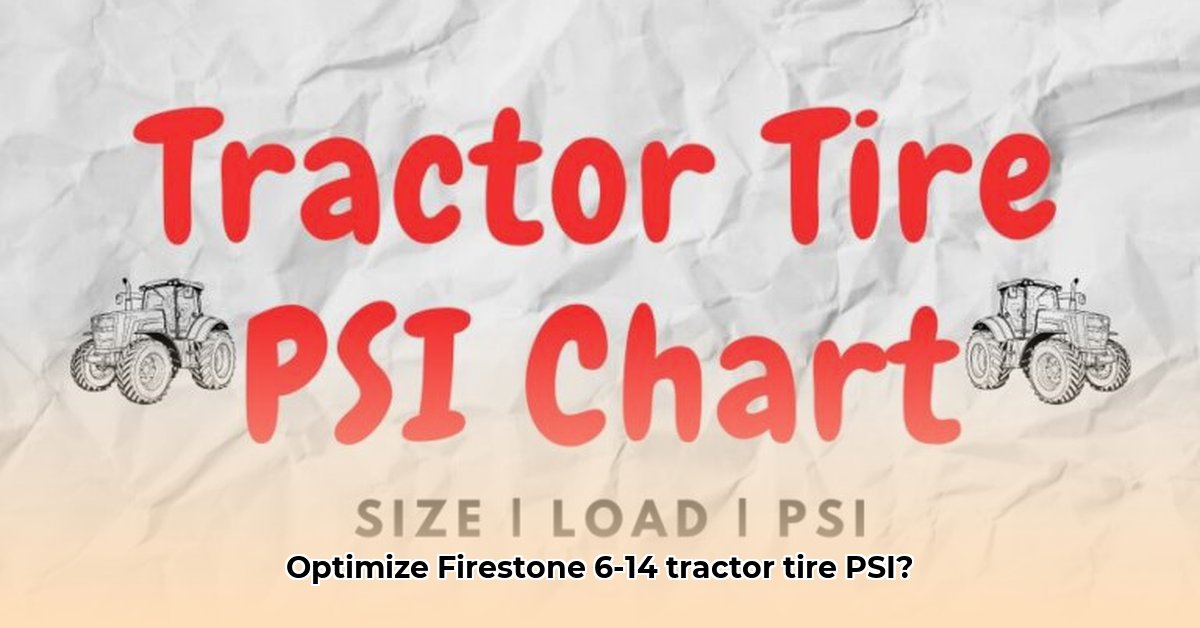
Understanding Firestone 6.00-14 Tire Specifications
Maintaining the correct tire pressure in your Firestone 6.00-14 tractor tires is crucial for fuel efficiency, soil health, and environmental sustainability. Let's delve into the specifics to ensure you're operating at peak performance. Incorrect inflation leads to increased fuel consumption, soil compaction, and premature tire wear – all impacting your bottom line and the environment. For more detailed information on tire pressure, check out this helpful resource: Tire Pressure Guide.
Finding the Right PSI: The ideal PSI is typically printed on the tire sidewall. If not readily visible, consult Firestone's official load/inflation tables. These tables correlate tire load (weight carried by the tire) with the recommended PSI. Heavier loads require higher PSI to maintain optimal performance and prevent damage.
Example PSI Chart (Consult Firestone's Official Chart for Accurate Data):
| Load (lbs) | PSI (Recommended) | Operating Conditions |
|---|---|---|
| 800 | 24 | Light loads; transport; light tillage |
| 1000 | 28 | Medium loads; general fieldwork |
| 1200 | 32 | Heavy loads; heavy implements; significant hauling |
| 1400 | 36 | Maximum load capacity; use sparingly; consult owner's manual |
Why is accurate PSI so important? Maintaining optimal tire pressure directly impacts your farm's environmental footprint. Don't overlook this simple yet powerful way to achieve sustainable farming.
The Impact of Proper Inflation: Fuel Efficiency & Soil Health
Correct tire inflation significantly impacts multiple aspects of your operation. The right PSI translates directly into a more efficient, sustainable, and profitable farming practice. Let's look at the key benefits:
Fuel Efficiency: Properly inflated tires reduce rolling resistance. This translates to less work for your tractor's engine, resulting in significant fuel savings and lower operating costs. Isn't that a compelling reason to check your tire pressure regularly?
Soil Health: Over- or under-inflation compacts the soil, hindering water infiltration and root growth—decreasing yields and increasing erosion. Maintaining the correct PSI promotes healthy soil structure, improving aeration and water retention. This in turn leads to superior crop yields and reduces the need for excessive tillage, keeping your soil healthy and fertile for years to come.
Tire Longevity: Correct inflation ensures even tire wear, extending the lifespan of your valuable investment and reducing the need for frequent, expensive replacements. Are you getting the maximum lifespan out of your tires?
Environmental Impact: Improved fuel efficiency directly reduces greenhouse gas emissions aligning with responsible environmental stewardship. This simple act of maintaining proper PSI contributes to the larger goal of sustainable agriculture.
Data-backed Question: Can you afford to ignore the significant fuel savings and environmental benefits of correctly inflating your tractor tires?
Step-by-Step Guide to Checking and Adjusting Tire Pressure
Checking and adjusting your Firestone 6.00-14 tire pressure is straightforward. Follow these simple steps:
Gather Your Tools: You'll need a reliable tire pressure gauge. Ensure accuracy for optimal results.
Prepare the Tire: Remove the valve cap from the tire valve stem.
Take the Reading: Press the gauge firmly onto the valve stem until you get a stable reading. Note the current PSI.
Adjust as Necessary: Add air using an air compressor or hand pump to raise the PSI to the recommended level for your load. If the pressure is too high, carefully release air using the valve stem until you reach the correct PSI.
Repeat: Check and adjust all four tires for consistent pressure.
Important Note: Always check tire pressure when the tires are cold (not recently driven). Temperature significantly impacts pressure readings.
Beyond PSI: Choosing Sustainable Tire Practices for Long-Term Success
The long-term health of your farm and the environment is a crucial consideration when it comes to tires. Strategic tire choices contribute greatly to sustainable farming practices:
Invest in Durable Tires: High-quality tires with robust tread designs will last longer, reducing waste and replacements. A small upfront investment can save you significant money and time over the long run.
Tire Recycling: Be aware of your tire disposal options. Look for manufacturers offering recycling programs.
Low Rolling Resistance Tires: Consider tires specifically designed for low rolling resistance when purchasing new tires, further enhancing fuel efficiency and environmental impact.
"Choosing sustainable tires is an investment in the future of your farm and the planet," says Dr. Emily Carter, Agricultural Engineer at the University of California, Davis. "The long-term benefits of reduced fuel consumption and environmental impact far outweigh the initial cost."
Conclusion: Maximize Your Farm's Efficiency and Sustainability
Maintaining the correct tire pressure in your Firestone 6-14 tractor tires is a simple yet profoundly impactful step towards sustainable and efficient farming. The combination of fuel savings, improved soil health, and reduced environmental impact makes properly inflated tires a keystone of smart agricultural practice. Regularly check your tire pressure and choose sustainable tires to maximize your farm's efficiency, profitability, and its contribution to a greener future.